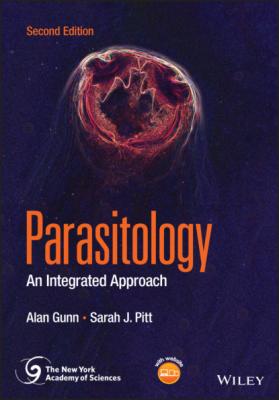Parasitology. Alan Gunn
Чтение книги онлайн.
Читать онлайн книгу Parasitology - Alan Gunn страница 22

DALY and DALY range data were derived from Hay et al. (2017). The mortality data were derived from the most recent year available at the time of writing and from various sources.
Although some workers have attempted to use economic costings for wildlife diseases, it is a controversial approach: how much is a blackbird worth? Indeed, there has been a tendency for parasitologists to view wildlife mainly from the perspective of their potential as reservoirs of disease for human infections or those of our domestic animals (Thompson et al. 2010). This has sometimes led to widespread culling of wildlife. For example, in parts of Africa it was once common practice to kill antelopes and other large game animals to prevent them acting as a reservoir of Trypanosoma brucei infection. Similarly, at the time of writing, the practice of culling badgers in the United Kingdom to prevent the spread of TB in cattle is proving hugely controversial and expensive. Its effectiveness is also debateable.
The rate of extinctions amongst animals and plants is proceeding at an alarming rate and with it the realisation that we need to do more to conserve them. This is not just an ethical issue, but it also has economic implications since wildlife tourism is big business in some countries. Any attempt at conserving an organism must consider the diseases it suffers from. In addition to natural infections, wild animals are also afflicted by parasites introduced to their habitat by humans. It would be wrong to consider natural infections as invariably benign and those introduced by humans as invariably malign. For example, until the introduction of the New World screwworm fly (Cochliomyia hominivorax) eradication campaign in the USA, one estimate suggested that it killed up to 80% of white‐tailed deer fawns in the southern states every year (Fuller 1962). The screwworm fly was present naturally and the eradication campaign was solely to prevent infections in cattle and other domestic animals, but the result was beneficial to wildlife too. More commonly, a parasite colonises a new area through contamination (e.g., in soil or ship ballast water) or through infections of us and our domestic animals. The consequences then depend upon whether the invading species finds other suitable hosts and, if it needs one, a suitable vector or intermediate host. The exposure of any naïve animal (or human) to an agent capable of establishing an infection in them often ends badly and if that agent can complete its life cycle in the area, then the consequences for the local population of new hosts is equally dire. For example, on the Galapagos Islands, the populations of several of the species of Darwin’s finches have been devastated following the arrival of the fly Philornis downsi. It probably came to the islands in the 1960s among imported fruit and vegetables. The adult flies are free living, but their blood‐feeding larvae are ectoparasitic on nestling birds and cause high mortalities (McNew and Clayton 2018). Wildlife tourism brings in hundreds of millions of dollars per year to the Galapagos Islands (https://www.galapagos.org/wp‐content/uploads/2012/01/TourismReport2.pdf). Although most people do not visit the Galapagos Islands to spot Darwin’s finches, the loss of iconic species such as the Giant Tortoises to introduced parasitic infections would undoubtedly have serious implications for the tourist industry.
1.8 Why Parasitic Diseases Remain a Problem
Whenever a seemingly simple but intractable problem arises, a commonly heard refrain is ‘if we can put a man on the moon, why can’t we do X, Y, or Z’. As we have seen, parasitic diseases cause suffering to us and to our domestic animals, and the economic costs are enormous. Furthermore, many diseases could be controlled by simple measures such as providing safe drinking water and appropriate waste disposal facilities. So, one might ask, why do parasitic diseases continue to afflict so many people and impact so heavily on agriculture?
As with so many apparently simple questions, the reason parasitic diseases remain a problem does not have a single simple answer and is also tied up with the most exasperating factor of all – human behaviour (Table 1.3). To begin with, human parasitic diseases are predominantly (although not entirely) a problem of poor people who live in insanitary conditions and who do not have a healthy diet. The diseases are therefore most prevalent in developing countries where neither the government nor individual people have money to spare. For example, in 2016 the total healthcare expenditure in Zimbabwe as a percentage of the gross domestic product (GDP) was similar to that of the United Kingdom (9.41% cf 9.76%) and considerably more than that of oil‐rich Saudi Arabia (5.74%) (https://data.worldbank.org/indicator/SH.XPD.CHEX.GD.ZS). However, in terms of total health expenditure per capita, the United Kingdom spent US$4192, Saudi Arabia US$1147, and Zimbabwe US $94 (https://knoema.com/atlas/Zimbabwe/Health‐expenditure‐per‐capita). Needless to say, US $94 does not buy many medicines.
Table 1.3 Summary of factors contributing to the problems of parasitic diseases.
| Poverty Lack of sanitation Complacency Poor nutrition Lack of health infrastructure Lack of government interest Corruption Urbanization Social conflict/wars Movement of non‐immune people to regions where they become infected from the resident population. Movement of infected people to regions where they infect non‐immune resident population Man‐made environmental damage Natural disasters Lack of effective drugs/ parasite resistance Increasing resistance of vectors/ intermediate hosts |
We humans are extremely adaptable creatures. Consequently, we can survive harsh environments, oppressive regimes, and cruel exploitation. Unfortunately, this adaptability can degenerate into acceptance and complacency on the parts of both individuals and governments. Because parasitic diseases are so prevalent in developing countries, there is a tendency not to prioritise them: fevers and diarrhoea become an accepted part of everyday life. Furthermore, parasitic diseases tend to cause chronic disease and although the patient may ultimately die, the condition does not capture the attention of the local